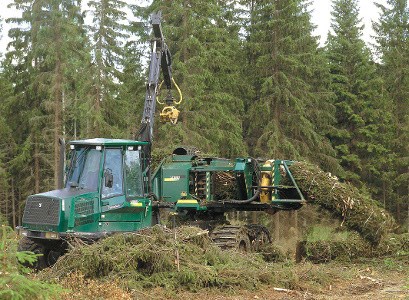A four-province panel discussion at the 2009 Ontario Professional Forestry Association conference and annual general meeting in Sudbury outlined where Ontario, New Brunswick, Quebec and British Columbia are heading.
A wave of change is coming to the Ontario forest industry, announced Bill Thornton, the Assistant Deputy Minister of the forest division with Ontario Ministry of Natural Resources.
It will come in three areas: timber licensing, disposition and pricing, he said.
"Ontario is not contemplating privatization," Thornton said emphatically.
The Ontario system does impede new business entrance and the government would like to manage the industry for a profit to develop a cushion for tough times and for forest management.
"But a fair system, not about making more revenue," is what Thornton wants to see.
Discussions are ongoing, and Thornton expects to hear recommendations from stakeholders and representatives from British Columbia, Quebec and New Brunswick.
"My gut tells me we will see different processes in various regions of the (Ontario) province."
Some sage wisdom may come from British Columbia's forest sector review, although it may be too early to tell.
They undertook a very tough review of it's forestry sector, said Bob Friesen, Assistant Deputy Minister for the British Columbia Ministry of Forests and Range.
"If we had not done it, the downturn in the economy would have overtaken us earlier than it did,” he said.
“Of the province's vast forest lands, 95 per cent is public owned, he said, and that won't change, at least not in my lifetime," Friesen said.
The British Columbia tenure system is unusually complicated, with more than 1,000 timber licenses, most of which are wood lots.
They are now into their sixth year and yet not enough time has passed to evaluate the reforms.
Moreover, in this market “it is not the time to try and tweak things," Friesen said.
The government did a lot to introduce market signals into the economy and to diversify, he said. They introduced a market pricing system in 2004, selling 20 per cent of their standing timber at auctions. The remaining 80 per cent is the set based on what the timber went for on the auction block.
"We have made all these changes to get government out of the way and let business make business decisions," Friesen said. "It's not perfect, but it's a long step forward. If it wasn't for the market collapse we would be seeing positive benefits."
British Columbia is currently examining where the forestry industry is headed, specifically the bio-market with 29 recommendations being made to improve the system, not thrown it out, Friesen said.
On the other side of Canada, Quebec is in the process of ushering in a "new forestry regime," said Andre D'Arcy spokesperson from the Quebec Ministry of Natural Resources and Wildlife.
There are three forestry areas in Quebec: protected areas, ecosystemic zones, and intensive production zones. Quebec has reviewed their pricing policy on the sale of timber.
"The plan is to have all the plans and orientation decided by the regional authorities,” D'Arcy said, explaining the government will disperse the contracts and all companies will be certified with the department.
The goal is to have a renewable resource that can provide revenue and jobs for the long term, he said.
The new forestry regime bill is expected to be tabled in the National Assembly of Quebec in 2009. It will be studied in the fall and hopefully implemented through a transition period to begin in 2011 through to April 1, 2013.
New Brunswick was the only one of the four regions not calling for change.
Paul Orser, Assistant Deputy Minister for the New Brunswick Department of Natural Resources said it's due in part to the community nature of their forest industry.
"A lot of good things are happening in New Brunswick forestry," he said.
"Our wood strategy for 2012 actually sacrifices wood volume for better quality.
Of the provinces approximately three million hectares of forest land, half is owned by the government, the other half by various sized private entities, Orser said.
New Brunswick uses a fair market value study to determine their royalty rates. Licenses and management efforts are reviewed every five years.
Facing a "once-in-a-lifetime" economic challenge, New Brunswick is now focusing on added value and bioenergy, Orser said.




